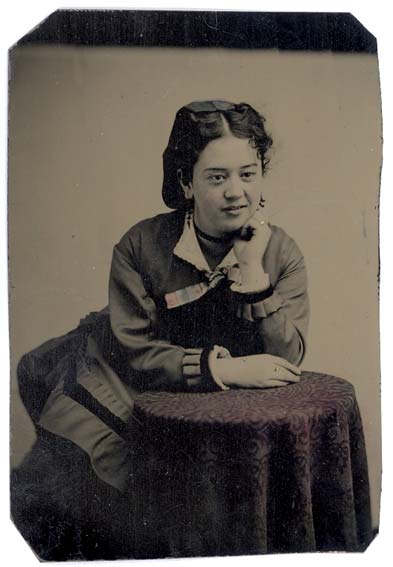







 |
Jump to
the tintype's gallery at the bottom of the page
Tintype
has been invented in 1853 by a French researcher - Adolphe Alexandre
Martin (1824-1896) - who was looking for a solution to simplify the work
of plate engravers.
Martin started first to improve the Ambrotype
photographic process but without significant success. One day, he decided
to replace the glass plate used in the Ambrotype process with black
enameled iron plate covered with collodion.
The result that he got was a positive image which was then easy to engrave
and print. Martin noticed in passing that the image was attractive to the
eye but this was not the objective of his research so he did not realize
the commercial potential of what he had discovered.
In 1855,
Hamilton Smith (1819-1903) a chemistry professor at Kenyon College in
Gambier, Ohio (US) discovers Martin’s works and decides to reproduce the
same experiment. One of his students - Peter Neff Jr - understands
immediately the potential offered by this cheap process of images
creation. Neff offers to his professor to organize the industrialization
of this process in exchange of patent rights. Patent is issued in February
1856 under the designation of «Melainotype». Later on, another student of
the Kenyon College - Victor Moreau Griswold - decides to compete with Neff
in the production of enameled iron plate. He decides to name his product «
Ferrotype ».
Like
Ambrotypes, the ferrotype plates are prepared with a sensitized collodion
substance coated on thin metal plates. These plates are previously covered
with a black enamel varnish. The obtained image is a direct positive one.
The process was simple, fast, cheap, giving good results. Due to this, the
Ferrotype was an outstanding success which continued to be used until the
beginning of WW II in Europe.
The
Ferrotypes have been produced in different formats and presentations.
 |
In Europe,
they were presented in decorated paper frames.
|
 |
In US, they
were put in images cases similar to the ones used for Daguerreotypes or
Ambrotypes. The invention of multi-lens cameras with revolving backs
allowed the production of tiny "Gem" tintypes, sold by set of 16 and
presented in CDV format.
|
Like the
other kinds of B&W images, ferrotypes also could be hand-tinted and
even beautifully overpainted by skilled photographic artisans. Nevertheless,
this type of picture can be damaged by scratching and abrasion. A beautiful
tintype, perfectly preserved, is rare.
(ndlr : My friend Paul has the most exceptional Ferrotype
I ever see... The one of Mrs Cotton).
United States, c.1862, gutta-percha case "Monitor" United States, c.1910-1915 United States, c.1865-1868
Portrait of a young woman
Probably taken by an itinerant photographer M.. Babbitt (Father of Miss Matie A.Babbitt). Miss Matie A.Babbitt
Born in Delaware township, she get married with Charles E.Blodgett on January 5th 18?? at 11am.
Charles E.Blodgett
He get married with Miss Matie A.Babbutt on January 5th 18?? at 11am. Portrait of a woman
Probably taken by an itinerant photographer An American family from Missouri. Unusual format of 12 x 18 cm. On the back of the "Monitor" gutta-percha case is written "I.N HODSON. 1840 Aug. 24".On checking, this gentleman was never listed onto the muster roll of the famous Yankee battleship named the "Monitor".
From the collection of Jacques Postel From the collection of Jacques Postel Everett Chace
Son of James K.Chace and Lucy Nye.Chace
Husband of Sarah Howarth
Father of Lucy Alice Howarth Chace Scovil. World's smallest tintype (25x20mm)
Tiny size of tintype produced only during the 1860s. The portrait is enclosed in its own embossed brass preserver, and each measures only 2.5 cm tall by 2 cm wide.
World's smallest tintype (25x20mm)
Tiny size of tintype produced only during the 1860s. The portrait is enclosed in its own embossed brass preserver, and each measures only 2.5 cm tall by 2 cm wide. World's smallest tintype (25x20mm)
Tiny size of tintype produced only during the 1860s. The portrait is enclosed in its own embossed brass preserver, and each measures only 2.5 cm tall by 2 cm wide. Three small portrais of the same young woman.
Probably taken by an itinerant photographer

Portrait of a young woman
Probably taken by an itinerant photographer
| |
 Nombre
de visiteurs Nombre
de visiteurs
Number of visitors |
|


